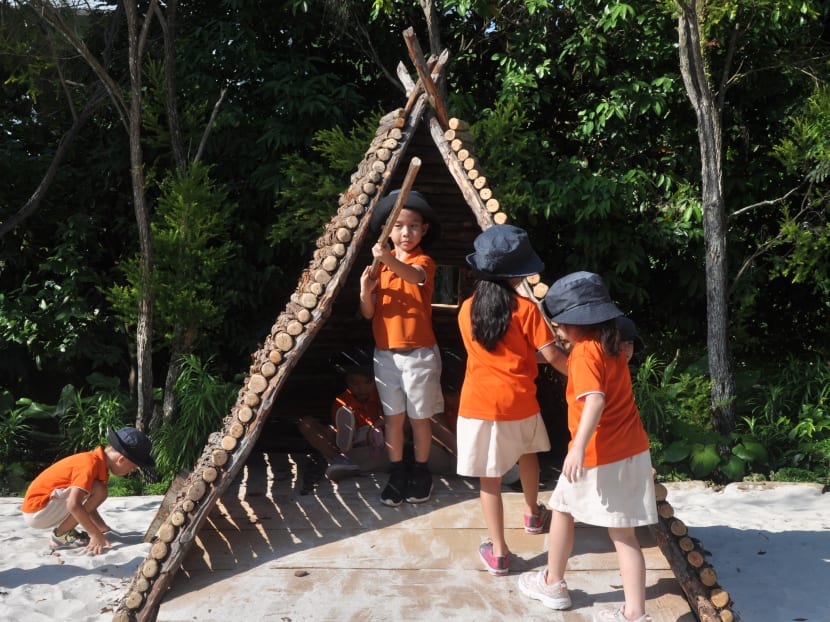NParks opens nature playground at HortPark as testbed for future ‘biophilic’ sites
SINGAPORE — At first glance, it might not look like much, with leaves, sand and some wooden blocks and poles in the ground. However, the new biophilic playground at HortPark has been specially designed to allow children to play freely with nature.
SINGAPORE — At first glance, it might not look like much, with leaves, sand and some wooden blocks and poles in the ground. However, the new biophilic playground at HortPark has been specially designed to allow children to play freely with nature.
Centred upon the concept of “biophilia”, the innate emotional connection that humans have with nature, research has shown that interacting with the outdoors helps children develop creativity.
The new play area will also be a testing ground for the National Parks Board (NParks) to develop design guidelines, by early 2020, to help pre-schools, government agencies and developers in building more of such sites around the island.
This is so that more playgrounds can adopt natural designs for children to experience biodiversity.
Speaking at the opening of the Nature Playgarden at HortPark on Tuesday (March 19), Mr Desmond Lee, Minister for Social and Family Development, said that NParks will introduce more of such biophilic play sites in other parks and gardens over the next two years.
Plans are also in place to enhance existing playgrounds to incorporate such elements.
“Interaction with the outdoors, getting out and about, has benefits for our children cognitively, physically and emotionally. We’d like our playschools to use the outdoors as an open classroom,” Mr Lee said.
“We’re very connected to the digital realm, and our children, too. We see them (using) their iPhones, iPads, digital devices. But if you look back on our own childhood, many of us spent time out in the backyard, in greenery, in the longkang (canal) catching fish, looking for spiders.”
At the opening of the HortPark playgarden, about 50 pre-school children from PCF Sparkletots and My First Skool had a chance to try out the features.
Ms Ong Siew Teng, executive principal of PCF Sparkletots, said that the children “really enjoyed” the playground.
“They got to interact with their friends, look at the natural elements, the wind, the sun, the water, and saw how the leaves cast shadows onto the floor,” she said.
Ms Ong, who has a three-year-old daughter, said that while some parents may worry about letting their children run about in the open, such activities help them develop confidence and resilience as well.
DESIGNED WITH NATURE IN MIND
The 0.35-ha playgarden at HortPark has nine different play features. Children may traverse a series of logs laid across a trench, hide in a bamboo dome, or work together to build “castles” using materials such as wooden planks and poles.
It is designed with nature in mind — offering, for instance, unimpeded views over open landscapes and plenty of spaces to hide.
Mr Tan Jun Chao, director for park planning at NParks, said that these will encourage children to engage in spontaneous play, adding “elements of mystery” to pique their curiosity.
Recycled materials have also been used for about 99 per cent of the site, making it sustainable. The remaining 1 per cent is the steel used to support a tunnel, to prevent it from caving in, “but of course we make it look natural”, Mr Tan said.
Safety was a priority when building the playground, he added, with all its features adhering to international guidelines.
“For example, the steps could not be too high. And if you notice, the rough edges were sanded down so they don’t cause splinters,” he said.
ON-SITE RESEARCH
Another goal of the initiative is to encourage educators and developers to build more of such playgardens, Mr Tan said.
Guidelines for creating such areas will be developed in consultation with the Early Childhood Development Agency and the National Institute of Early Childhood Development.
For example, suitable plants, materials, and designs will be recommended for various site conditions and requirements.
These will be based on research that will be done at the HortPark site, to be completed by end-2019.
Researchers will observe how children interact with the site’s play features, and see if the children really use them the way they were intended.
If not, adjustments will made and fed into the guidelines, so that developers have information on how to build future play areas.
Beyond the HortPark playgarden, NParks said that it will implement several other nature-centric playgardens islandwide over the next two years.
The play area at Sengkang Riverside Park will be redeveloped using similar design principles, and there will be new playgardens at Pasir Ris Park and the upcoming Gallop extension of the Singapore Botanic Gardens.







